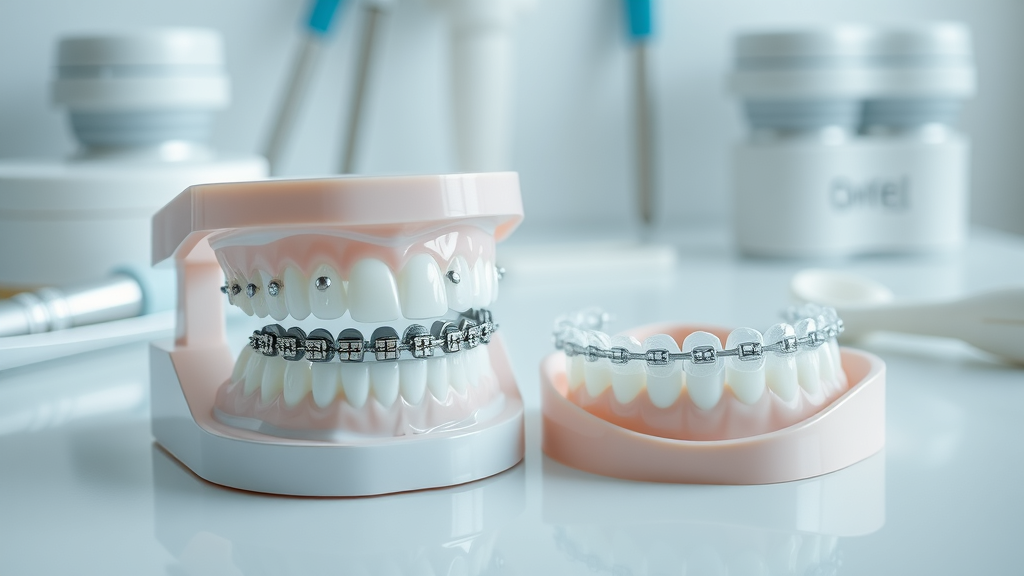Is your quest for a perfectly straight smile leading to a lifetime of confidence, or could your choice between braces and aligners mean trading lasting results for short-term gains? Let’s dive deep into the long-term results: do braces or aligners last longer—and how to make your investment in orthodontics truly count.
Unlocking the Truth: Do Braces or Aligners Offer Better Long-Term Results?
"Are you investing in a lifetime smile, or just a short-term fix? Discover the lasting impact of your orthodontic choice."
- Key questions explored: longevity of braces vs. aligners, treatment time, tooth movement, and durability.
Choosing the best way to straighten your teeth can be overwhelming. The true challenge lies not just in achieving a perfect smile, but in ensuring your results last for years to come. Are traditional braces built for the long haul, or do clear aligners such as Invisalign rival their staying power? In this comprehensive guide, we address the long-term results: do braces or aligners last longer? by comparing durability, effectiveness, post-treatment care, and more. Whether you’re an adult seeking a discreet solution or a parent hoping for the best future for your child’s oral health, the upcoming insights and expert perspectives will empower you to make an informed, smile-worthy decision.
We’ll dig into how metal brace technology has evolved, what makes clear aligners so appealing, and offer practical guidance for maintaining straight, healthy teeth for life. By understanding the differences in treatment, follow-up care, and patient compliance, you’ll unlock new confidence in your orthodontic choice.
What You’ll Learn – Longevity of Braces and Aligners
- Understand long-term results: do braces or aligners last longer?
- Compare metal braces, clear aligners, and traditional braces
- Maintenance tips for lasting results
- Factors influencing retention and relapse
| Treatment Option | Durability | Effectiveness for Complex Cases | Risk of Relapse | Main Post-Treatment Need |
|---|---|---|---|---|
| Metal Braces (Traditional) | Very High | Excellent | Low-Moderate (with retainer) | Fixed or Removable Retainer |
| Clear Aligners (e.g., Invisalign) | Moderate–High | Good for Mild to Moderate Cases | Moderate (compliance-dependent) | Removable Retainer (daily wear) |
| Ceramic Braces | High | Good | Low–Moderate (with retainer) | Fixed or Removable Retainer |

Overview of Long-Term Results: Do Braces or Aligners Last Longer?
When considering long-term results: do braces or aligners last longer?, it’s crucial to define what “lasting results” really mean in orthodontic treatment. Durability isn’t simply measured in years, but by how well your teeth remain straight, functional, and healthy once active treatment ends. Braces and aligners both excel at moving teeth and correcting alignment issues, but their approach, maintenance, and retention needs can differ. Why do some patients experience relapse years after their initial treatment, and how much does patient responsibility play a part?
This section sets the foundation by explaining the factors that impact lasting smile transformations. We’ll look at what influences tooth movement, the common timeline for results, and how each treatment manages the risk of your teeth shifting over time. If the enduring success of your smile is important to you, understanding these frameworks is the crucial first step.
Defining Long-Term Results: What Matters Most in Orthodontics?
Long-term results in orthodontics refer to keeping your teeth straight, your bite healthy, and your smile confident for years after active treatment ends. The ideal scenario? You complete your orthodontic treatment, transition into retainer use, and enjoy a stable bite and well-aligned teeth into adulthood. However, key factors impact this goal—such as genetics, how your teeth moved during treatment, and whether you stick to wearing your retainer. The best results come from a match between the right treatment plan (be it metal braces or clear aligners), consistent aftercare, and habits that support oral health.
Additionally, “lasting” means more than years on the calendar; it includes resilience against changes from age, injury, or shifting jaws. In comparing metal brace vs. aligners, we must look at their ability to handle complex cases, withstand daily wear and tear, and maintain results with realistic lifestyle habits. A straight smile isn’t just cosmetic—it supports dental health, speech, and comfort for a lifetime.
The Importance of Retention After Metal Braces vs. Clear Aligners
Retention is the backbone of lasting orthodontic success. No matter how perfectly metal braces have moved your teeth or how seamless your clear aligner treatment felt, without a solid post-treatment retention plan, relapse remains a real threat. Retainers—whether they’re fixed wires bonded to your teeth or removable trays—work to hold your smile in place as bone and tissue adapt to new positions. Because metal braces often treat more complicated alignment issues, patients are sometimes prescribed longer or more rigorous retainer use.
For clear aligners, retention is just as vital. Many aligner systems come with a final set of trays designed to be worn nightly for years. The bottom line: braces or aligners, both demand discipline after active treatment. Skipping retainers can undo months or years of progress, regardless of which tooth-straightening option you chose. Commitment to retention is the secret to a lifetime of straight teeth.
Metal Braces vs. Clear Aligners: Longevity and Lasting Outcomes
How Metal Braces Deliver Long-Term Results
- Traditional metal braces
- Brackets and wires
- Treatment time
- Durability concerns
Metal braces have long been the gold standard for comprehensive, predictable, and lasting orthodontic outcomes. They use sturdy brackets and wires to correct even the most severe orthodontic issues, from bite problems to tooth crowding. The design of traditional metal braces makes them highly effective at exerting continual pressure, guiding teeth into their new positions. The average treatment time for metal braces runs from 18 months to three years, depending on complexity.
What gives metal braces their longevity is their reliability: they’re fixed to the teeth, ensuring that movement is incremental, stable, and monitored. Metal brackets and wires resist breakage, and the controlled force allows orthodontists to address complicated tooth movements, giving patients with difficult alignment issues a better shot at lasting results. Advances in brace technology, like smaller and more comfortable brackets, have enhanced both aesthetics and resilience—making sure your treatment not only lasts during those pivotal months, but supports oral health for years post-treatment.
Clear Aligners and Longevity: Are They Built to Last?
- Clear aligners
- Clear aligner systems
- Average treatment time
- Post-treatment care
Clear aligners—like Invisalign—are celebrated for blending convenience, aesthetics, and effective tooth movement, especially for mild to moderate cases. Each custom-made set of aligners is nearly invisible and removable, so you can eat, brush, and floss without wires in the way. The treatment duration often averages 12–18 months but varies based on alignment issues and how often you wear your trays (ideally 20–22 hours/day).
But do clear aligners deliver long-term results on par with metal braces? Research and orthodontist feedback suggest they do, provided patients are disciplined with retainer use post-treatment. Since aligners and braces both rely heavily on aftercare, patients who skip nightly retainers may see shifting. Aligner trays aren’t meant to last forever—they’re replaced every week or two during treatment—but the final retainers can maintain your newly straightened smile indefinitely.
Traditional Braces: Does the Classic Approach Still Win in the Long Run?
- Traditional brace innovations
- Straightening teeth outcomes
- Retention over time
The time-tested approach of traditional braces remains the preferred choice for many orthodontists, particularly when treating complex dental cases. Innovations in the design of traditional braces, including options like ceramic brackets, have made them more comfortable and aesthetically appealing than in decades past. Their enduring popularity comes down to control: fixed brackets and wires let your orthodontist fine-tune every stage of tooth movement—even in the most difficult scenarios.
Lasting results from traditional braces depend on two key factors: the thoroughness of active treatment and the rigor of retention protocols afterward. Modern retention strategies, such as bonded retainers or custom removable trays, are designed to hold results for a lifetime with the right care. This classic approach, when combined with regular orthodontic check-ins, remains tough to beat for durability and consistency—even as clear aligners gain ground for more straightforward alignment issues.
Braces or Invisalign: Which Is the Best Investment for Lasting Smile?
- Braces and Invisalign compared side-by-side on long-term effectiveness
When weighed side-by-side, both traditional braces and Invisalign offer impressive potential for lifetime results—when backed by proper follow-up. Braces have a slight edge for complex alignment cases or when patient compliance may be unreliable, since they’re fixed and always working. Invisalign and other clear aligners appeal to those valuing aesthetics and convenience, and can provide equally enduring results for those committed to wearing their post-treatment retainers.
Ultimately, the “best investment” depends on your specific needs: case complexity, lifestyle, commitment to aftercare, and personal preferences. Consulting an experienced orthodontist is the best way to tailor your treatment plan to your goals for a healthy, straighter teeth—and a smile that lasts.

Key Factors Impacting Long-Term Results: Do Braces or Aligners Last Longer?
Patient Compliance: The Role of Responsibility and Habits
No orthodontic solution works without patient commitment. For clear aligners, their greatest strength—removability—can be a weakness if aligners aren’t worn as prescribed. Even after active treatment, using retainers consistently is key to preventing relapse. In contrast, metal braces are fixed; you can’t remove them, so teeth are constantly under corrective pressure. Still, retainer compliance is non-negotiable regardless of system.
Responsible habits, from brushing around metal brackets to safely storing aligners and always wearing your retainer, are at the heart of lasting outcomes. Ask any orthodontist: the best clinical work can be undone by poor patient habits. If you want your investment to pay off in a healthy smile for life, consistent aftercare is non-negotiable.
Tooth Movement: Is There a Difference Between Metal Braces and Clear Aligners?
Metal braces and clear aligners both move teeth through controlled pressure, gradually aligning your smile. The main difference is how that pressure is applied. Braces use brackets and wires that are adjusted by an orthodontist, allowing detailed manipulation for complex cases. Aligners, on the other hand, move teeth with shape memory plastic, each tray reflecting incremental changes in alignment.
For difficult alignment issues or cases needing significant tooth movement, traditional metal braces often have an advantage in precision and control. But for mild to moderate crowding or spacing, the efficiency and comfort of aligners are hard to beat. The science is clear: both options provide significant, safe movements—but understanding your own case is essential.
Treatment Time: Does Longer Mean Better?
Length of treatment time often varies based on case complexity, with traditional braces typically requiring 18–36 months and clear aligners taking 12–24 months. Patients sometimes assume longer treatment guarantees better results. However, optimal orthodontic treatment is about efficiency, thorough planning, and consistent progress, not simply duration.
Whichever method you choose—metal braces or aligners—the priority is achieving your treatment goals with minimal complications and a clear, sustainable plan for the retention phase that follows. Discussing expected timelines and end results with your orthodontist will help you set realistic goals and understand what “lasting” really means in practice.
Brackets and Wires vs. Removable Aligners: The Retainer Debate
The debate around brackets and wires versus removable aligners continues even after treatment. Both systems require retainers to lock in your new smile. Braces typically transition to fixed (bonded) or removable (plastic) retainers, aiming to prevent newly straightened teeth from drifting. Clear aligners often end with a similar tray-style retainer—one you’ll need to remember to wear nightly and replace as needed.
The verdict? Retainers are the great equalizer. Both traditional and aligner-treated patients must commit to ongoing retention if they want the benefits—whether that means straighter teeth or avoiding costly, time-consuming retreatment.
Stability, Retainers, and Relapse: Maintaining Your Smile After Treatment
Post-Treatment Protocols: Why Retainers are Essential Whether You Choose Braces or Aligners
- Retainer alternatives
- Retention strategies
- Relapse risks with metal braces and aligners
Whether you’ve finished with metal braces or a custom set of clear aligners, your aftercare journey is only beginning. Retainers—fixed, removable, or even newer permanent options—are the cornerstone of stable, lifelong results. Skipping wear, forgetting nighttime protocols, or neglecting retainer care can result in relapse: your teeth slowly returning to pre-treatment positions.
An honest conversation with your orthodontist about retention options and risks helps avoid disappointment later. Be open about your habits and preferences so you can develop a strategy that fits your life and maximizes lasting results. Consider your retainer as insurance on your new smile—a small daily commitment that pays off for years to come.

Expert Quotes: What Orthodontists Say About Long-Term Results — Do Braces or Aligners Last Longer?
"Many patients believe clear aligners are less effective in the long-term, but patient compliance makes all the difference." — Dr. Thompson, DDS
"Metal braces offer predictable, lasting change — but only if post-care is strictly followed." — Dr. Lee, Orthodontist
Common Challenges and Misconceptions Regarding the Long-Term Results of Braces and Aligners
- Myth: Clear aligners are always less durable
- Myth: Braces guarantee better results
- Fact: Relapse can occur with either option without proper retention

Lists: Benefits & Drawbacks — Long-Term Results: Do Braces or Aligners Last Longer?
-
Pros and Cons of Metal Braces:
- Excellent for complex cases and difficult tooth movement
- Always working—no risk of forgetting to wear
- Visible, can be uncomfortable or cause mouth sores
- Require diligent cleaning and oral hygiene
-
Pros and Cons of Clear Aligners:
- Nearly invisible, easy to remove for meals and brushing
- Effective for mild to moderate cases, comfortable fit
- Results dependent on wearing 20–22 hours/day
- Trays can be lost or damaged; ongoing discipline needed
-
Pros and Cons of Traditional Braces:
- Time-tested durability, suitable for all ages
- Predictable, consistent outcomes with proper care
- Visible and sometimes inconvenient for sports or certain foods
- Easy transition to long-term retainer solutions

People Also Ask — Your Orthodontic Longevity Questions Answered
Are aligners or braces more effective?
The answer depends on treatment goals, compliance, and individual cases. Metal braces are typically more effective for complex cases, while clear aligners suit mild to moderate corrections.
For patients with severe alignment issues or those who may forget to wear their appliances, metal braces are fixed and always in action. Clear aligners work wonders for less complex scenarios but depend on you wearing each set of aligners as instructed. The most effective choice is the one that fits your needs and your commitment level.
Why don't dentists recommend Invisalign?
Some dentists avoid recommending Invisalign for severe orthodontic cases due to perceived limitations in tooth movement or patient compliance, but for many cases, they are highly effective.
Dentists may prefer traditional braces for cases that require complex tooth movements, jaw corrections, or where reliability is a concern due to patient age or history. For many teens and adults with mild issues, however, Invisalign can deliver excellent, lasting results.
How long do aligners usually last?
Clear aligner trays are typically changed every 1-2 weeks, but results can last a lifetime with proper retainer use.
The individual clear aligner trays during active treatment aren’t designed for long-term wear. Post-treatment, a custom retainer—often from the same material—is used long-term. Follow your orthodontist’s retention plan to enjoy your straight smile for years to come.
Why do people quit Invisalign?
Common reasons include discomfort, difficulty following wearing instructions, or underestimating the responsibility required for success.
Successful clear aligner treatment depends on diligent, daily compliance. Some patients may find the routine disruptive or underestimate the need for all-day wear. Open communication with your orthodontist and realistic expectations are essential for lasting results.
Watch our explainer video for a side-by-side comparison of long-term outcomes, featuring real patient testimonials, orthodontist insights, and engaging animations showing how teeth move and stabilize with each treatment option.
FAQs: Long-Term Results with Braces and Aligners
-
What’s the relapse rate for braces vs. clear aligners?
Relapse can happen with any system, but rates are lowest when retainers are worn as instructed after treatment, regardless of whether you had braces or aligners. -
Can I switch from braces to aligners mid-treatment?
In many cases, yes. Your orthodontist can assess whether transitioning is possible based on your unique needs and treatment progress. -
How important is aftercare for preserving results?
Aftercare (especially retainers and regular check-ups) is vital for keeping your teeth straight in the long run and preventing unwanted shifting.
Key Takeaways: Achieving Enduring Results with Braces or Aligners
- Patient compliance and retention are key
- Both options can offer lifetime results with proper care
- Choose based on lifestyle, case complexity, and personal goals
Conclusion: Making an Informed Choice for Lasting Orthodontic Results
- Weighing the long-term results: do braces or aligners last longer should guide your orthodontic investment
- Consult with an orthodontist for a personalized treatment plan
Call To Action – Stay Informed for Your Best Smile
- Your smile is worth it — and staying informed is the first step. Join hundreds of locals already following Grand Strand Smile Spotlight for updates, advice, and trusted care insights.
- Subscribe now to get the latest Grand Strand orthodontic guides, tips, and updates — right to your inbox. No spam. Just smiles.
- Want more expert-backed answers about braces, Invisalign, and local orthodontic care? Subscribe to Grand Strand Smile Spotlight and stay ahead of your smile journey.
When considering the long-term effectiveness of orthodontic treatments, both traditional braces and clear aligners like Invisalign have demonstrated significant improvements in dental alignment and occlusal stability over extended periods. A retrospective study involving 200 subjects found that both methods effectively corrected malocclusions, with patient satisfaction scores consistently higher in the Invisalign group. (pubmed.ncbi.nlm.nih.gov)
Treatment duration varies between the two options. Traditional braces typically require 18 to 36 months, depending on the complexity of the case. In contrast, clear aligners often complete treatment in 6 to 18 months, making them a faster option for many patients. (brightestsmilesdental.com)
Regarding long-term stability, both treatments have shown comparable outcomes. A randomized controlled trial indicated that while patients with simple malocclusions required approximately 4.8 months longer treatment times with aligners than traditional braces, the treatment and 6-month post-treatment occlusal outcomes were similar. (pmc.ncbi.nlm.nih.gov)
In summary, both traditional braces and clear aligners are effective in achieving and maintaining dental alignment over the long term. The choice between them should be based on individual treatment goals, case complexity, and personal preferences.
 Add Row
Add Row  Add
Add 




Write A Comment